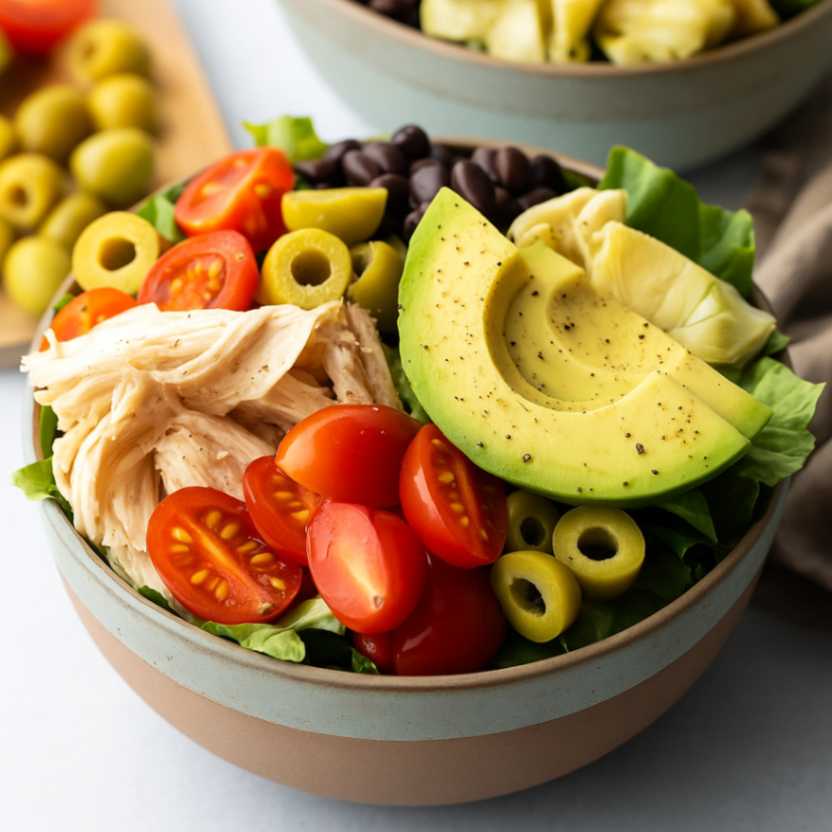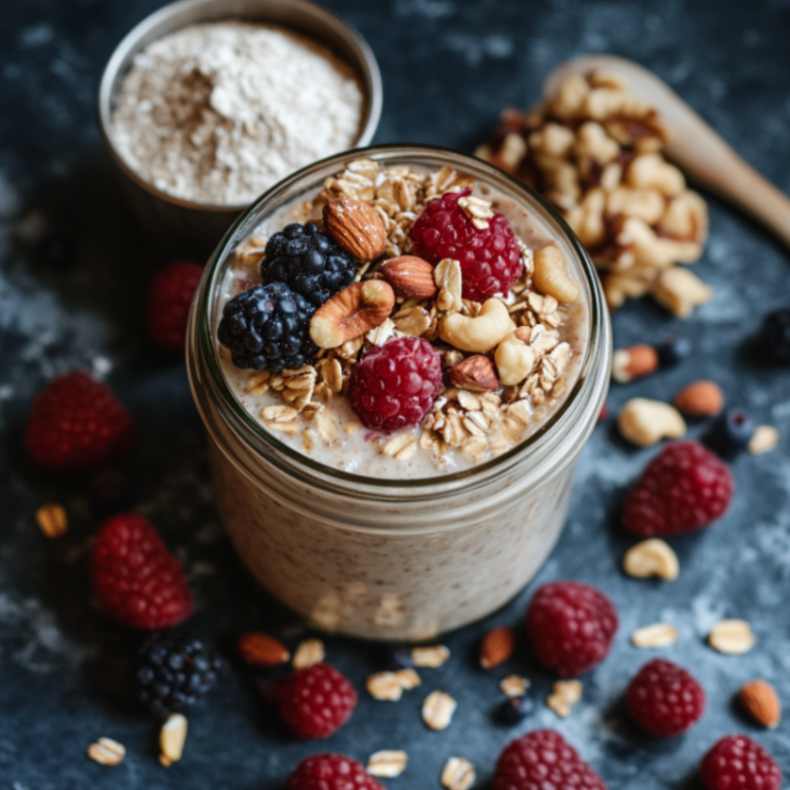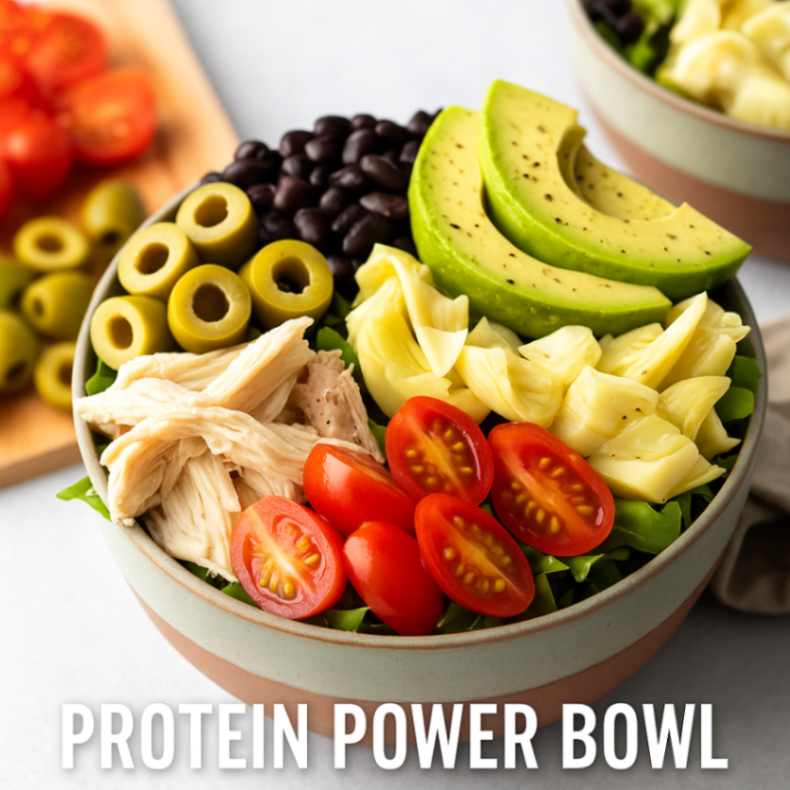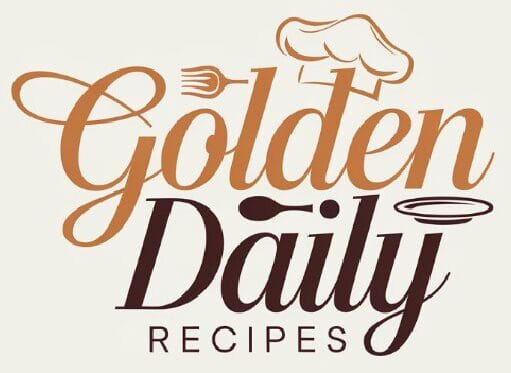If you’re tired of meal prepping, sick of standing over a stove, or just looking for ways to simplify your diet without sacrificing nutrition, a no-cook protein meal might be your new best friend. With more people focusing on wellness and time efficiency, these meal options are quickly becoming a go-to solution for fitness lovers, professionals, and even students.
A no-cook protein meal is exactly what it sounds like—meals rich in protein that require zero cooking. Whether you’re aiming to hit your daily macros, lose weight, build muscle, or just make eating healthy easier, these meals fit seamlessly into your lifestyle. From protein shakes to power bowls and snacks, the options are endless and tasty.

Table of Contents
Benefits of No-Cook Protein Meals
Why No-Cook Protein Meals Are Gaining Popularity
So why is the no-cook protein meal trend taking off? One reason is pure convenience. In today’s on-the-go world, cooking three meals a day is rarely realistic. These protein-rich, no-heat meals let you save time without skipping on nutrients.
Another reason is versatility. Whether you’re vegetarian, on a keto diet, or eating clean, you can craft a no-cook protein meal with ingredients tailored to your goals. From dairy-based proteins like Greek yogurt and cottage cheese to vegan options like tempeh or protein-rich hummus, the variety is impressive.
Plus, there’s less waste and fewer dishes. No pans. No ovens. Just quick meals you can prep and enjoy instantly.
Time-Saving and Convenience for Busy Lifestyles
Life doesn’t pause, and when you’re short on time, a no-cook protein meal can save your day. These meals are especially useful for:
- Quick breakfasts that power your morning
- Midday meals between meetings
- Post-gym recovery meals
- Nighttime snacks that support your fitness goals
A well-planned no-cook protein meal delivers just as much nutrition—sometimes even more—than a cooked dish. The secret is combining high-quality protein sources like hard-boiled eggs, canned tuna, nuts, seeds, protein powders, and dairy to meet your needs quickly and easily.
Looking for inspiration? Try this guide to high-protein meals under $10.

Understanding Protein Needs
How Much Protein You Need Per Meal
Before building the perfect no-cook protein meal, it’s essential to understand how much protein your body actually needs. While exact amounts vary depending on age, gender, activity level, and fitness goals, a general recommendation for adults is around 0.36 grams of protein per pound of body weight.
That means someone weighing 150 pounds should aim for at least 54 grams of protein per day. For those active in sports, resistance training, or muscle building, the number jumps to 0.6–0.9 grams per pound, or 90–135 grams daily.
Breaking that down by meal, a target of 25–40 grams per meal ensures consistent energy, improved muscle maintenance, and better recovery throughout the day.
Here’s a quick look at how much protein you may need:
| Weight (lbs) | Sedentary (g/day) | Active (g/day) | Per Meal (3 meals/day) |
|---|---|---|---|
| 130 | 47 | 78–117 | 26–39 |
| 150 | 54 | 90–135 | 30–45 |
| 180 | 65 | 108–162 | 36–54 |
For every no-cook protein meal, aim to stack protein sources like Greek yogurt, eggs, nuts, or protein powder to hit your target.
Protein Intake by Lifestyle: Athletes, Weight Loss, and Maintenance
Not everyone eats with the same goals in mind. If you’re building muscle, your no-cook protein meals should be protein-dense and include healthy fats to help you stay full and support muscle repair.
Trying to lose weight? High-protein meals help curb cravings and preserve lean mass while you’re cutting calories. In fact, research shows that eating 30g of protein per meal can increase satiety and reduce snacking.
Here’s how different lifestyles adjust their protein goals:
- Athletes & gym-goers: Opt for whey protein shakes, tuna packets, jerky, or cottage cheese for quick, no-heat protein.
- Weight loss seekers: Stick with leaner protein options like egg whites, plant-based powders, or non-fat Greek yogurt.
- General health: Combine moderate protein sources like hummus, beans, or nuts with fresh veggies for balance.
Don’t miss our global twist on protein-rich recipes like the Brazilian Mounjaro dish.
Top Sources of No-Cook Protein
Animal-Based Protein Sources That Don’t Require Cooking
When it comes to building a solid no-cook protein meal, animal-based proteins are often the most concentrated and easy to use. You don’t have to fire up a stove to get a high-quality dose of protein—just open, assemble, and eat.
Here are some of the best animal-based options:
- Canned Tuna & Salmon: A pantry staple that delivers around 20–25g of protein per 3 oz. Choose versions packed in water for a leaner option.
- Greek Yogurt: Thick, creamy, and perfect for layering with fruit or granola. One cup contains up to 20g of protein.
- Cottage Cheese: With 13–15g of protein per ½ cup, it’s a great addition to bowls or eaten plain.
- Hard-Boiled Eggs (pre-cooked): Ready-to-eat and rich in both protein and healthy fats. Two eggs provide about 12g of protein.
- Jerky & Dried Meats: Beef, turkey, or chicken jerky can pack 9–15g per serving and are perfect for snacking.
- Cold Deli Meats: Opt for nitrate-free turkey, ham, or roast beef—each slice gives you a protein boost without needing heat.
Keep a mix of these in your fridge and pantry to whip up a fast, balanced no-cook protein meal anytime.
Plant-Based & Vegan Protein Options Without Cooking
Going meatless? No problem. There are plenty of vegan-friendly ingredients that make excellent building blocks for a no-cook protein meal—no stove required.
Here are the top plant-based protein picks:
- Chickpeas & Beans (canned): Rinse and go. A half-cup of chickpeas contains around 7g of protein.
- Lentils (pre-cooked): Available vacuum-packed or canned, and they provide 9g of protein per ½ cup.
- Hummus: A tasty spread made from chickpeas that delivers 2g of protein per 2 tbsp.
- Nut Butters: Almond, peanut, and cashew butter offer 6–8g of protein per 2 tbsp, plus healthy fats.
- Tofu (firm or silken): Eaten cold or blended into shakes, tofu contains 10g+ of protein per ½ cup.
- Edamame (pre-cooked, refrigerated): These young soybeans pack about 8g per ½ cup.
Pairing several of these can help you create a filling no-cook protein meal that supports a plant-based diet.
Discover great ideas like our protein-packed smoothies guide to enhance your no-cook eating routine.
Easy No-Cook Protein Meal Ideas
Breakfast Protein Meals You Don’t Have to Cook
Mornings are often the busiest time of day. A no-cook protein meal for breakfast lets you fuel up fast without skipping nutrition. The goal is to combine protein-rich ingredients with a bit of fiber and healthy fat to keep you satisfied until lunch.

Here are a few grab-and-go, high-protein breakfast ideas:
1. Greek Yogurt Power Bowl
- 1 cup plain Greek yogurt (20g protein)
- 1 tbsp chia seeds (3g protein)
- ¼ cup almonds (5g protein)
- Berries and a drizzle of honey
2. Overnight Oats with Protein Powder
- ½ cup oats + 1 scoop protein powder (25g protein)
- ¾ cup almond milk
- 1 tbsp peanut butter
- Store overnight in a jar
3. Hard-Boiled Egg Snack Box
- 2 eggs (12g protein)
- 1 string cheese (6g protein)
- A handful of walnuts (4g protein)
- Baby carrots or cucumber slices
These options make it easy to hit 30g of protein before your day even begins without touching a stove.
Lunch and Dinner Recipes with High Protein, No Heat Required
A successful no-cook protein meal for lunch or dinner should check three boxes: protein, fiber, and healthy fat. These combinations create a balanced meal that stabilizes blood sugar, supports muscle repair, and keeps hunger at bay.
1. Tuna Avocado Wraps
- 1 pouch tuna (20–25g protein)
- ½ avocado mashed
- Lettuce leaves for wrapping
- Optional: squeeze of lemon, hot sauce
2. Chickpea and Cottage Cheese Bowl
- ½ cup canned chickpeas (7g protein)
- ½ cup cottage cheese (13g protein)
- Sliced cucumbers, cherry tomatoes
- Olive oil and lemon juice dressing
3. Protein Snack Plate (Adult Lunchable)
- Turkey slices (15g protein)
- Cheese cubes (7g protein)
- Hummus (2–3g protein)
- Bell pepper slices and olives
4. Tofu Pita Pocket
- ½ cup firm tofu (10g protein)
- 2 tbsp hummus (2g protein)
- Mixed greens and shredded carrots
- Stuffed in a whole-wheat pita
Protein Smoothies and Shakes as Complete Meals
DIY No-Cook Protein Shake Recipes
Protein shakes aren’t just for post-workout recovery anymore. With the right ingredients, they can serve as a complete no-cook protein meal—perfect for breakfast, lunch, or an afternoon boost.
Here’s what makes a smoothie meal-worthy:
- A solid base of protein (20g or more)
- Healthy fats like nut butter, chia, or flaxseed
- Fiber-rich carbs like oats, fruits, or vegetables
- Optional extras like greens, collagen, or adaptogens
Power Protein Smoothie (30g+)
- 1 scoop whey or plant-based protein powder (20–25g protein)
- 1 tbsp almond butter (4g protein)
- ½ frozen banana
- 1 cup almond milk
- 1 tbsp ground flaxseed
- Blend until smooth
Green Protein Shake
- 1 scoop vanilla protein powder
- 1 cup spinach
- 1 tbsp chia seeds
- ½ avocado
- 1 cup oat milk
- Optional: cinnamon or turmeric
These options take minutes to make and can even be prepped in freezer bags ahead of time. They’re nutrient-dense and hit the mark for a balanced no-cook protein meal that travels well.
How to Reach 30g–40g of Protein with a Smoothie
One of the most common questions people ask is how to build a smoothie that hits that magical 30g to 40g of protein. It’s easier than you think.
Tips for High-Protein Smoothies:
- Always use a full scoop of protein powder (aim for at least 20g per serving).
- Add Greek yogurt or cottage cheese (10–15g per ½ cup) to thicken and boost protein.
- Toss in seeds or nut butters for extra protein and fat.
- Use cow’s milk or high-protein plant milks instead of water for an added bump.
Here’s a combo that gets you close to 40g:
- 1 scoop protein powder (25g)
- ½ cup Greek yogurt (10g)
- 1 tbsp peanut butter (4g)
Boom—39 grams of protein in a delicious, drinkable no-cook protein meal.
Frequently Asked Questions
What protein doesn’t need to be cooked?
A wide range of proteins can be eaten without cooking, making them ideal for any no-cook protein meal. Examples include:
Canned tuna and salmon
Pre-boiled eggs
Greek yogurt
Cottage cheese
Protein powder
Jerky (beef, turkey, chicken)
Nut butters
Cold cuts (nitrate-free preferred)
These are perfect for building fast, high-protein meals without a stove or oven.
How to get 30g of protein each meal?
Getting 30g of protein per meal is all about stacking protein-rich ingredients. Here’s a sample combo:
1 scoop of whey protein powder (25g)
1 tbsp almond butter (4g)
½ cup Greek yogurt (10g)
Mixing multiple sources ensures you’re hitting your protein goals with variety and taste—essential for maintaining consistency with your no-cook protein meal routine.
How many scrambled eggs are 30 grams of protein?
One large egg contains about 6g of protein. So, you’d need:
5 scrambled eggs = ~30g of protein
But if you’re sticking to no-cook protein meals, opt for hard-boiled eggs or pair 2–3 with cheese or yogurt to hit your target without cooking.
Conclusion
Whether you’re running late, hitting the gym, or just avoiding a hot stove, a no-cook protein meal can give you the fuel your body needs without the hassle. With a little planning and creativity, you can enjoy breakfasts, lunches, dinners, and shakes that are protein-packed, delicious, and ready in minutes.
From tuna wraps and snack boxes to protein shakes that rival full meals, this approach works for every lifestyle. Plus, with so many high-protein ingredients that require no heat, you’ll never run out of ideas.

No-Cook Protein Power Bowl
Ingredients
Method
- Start by layering the mixed greens at the bottom of your bowl.
- Arrange the black beans, avocado, shredded chicken, cherry tomatoes, olives, and artichoke hearts on top.
- Sprinkle with salt and pepper.
- Add a light drizzle of olive oil or fresh lemon juice if desired.
- Serve immediately or refrigerate for up to 1 day.
Notes
- You can substitute shredded chicken with tuna, boiled eggs, or chickpeas for different protein sources.
- For a vegan version, use tofu or tempeh and skip the chicken.
- Want extra flavor? Add a drizzle of your favorite vinaigrette or tahini dressing.
- This bowl is meal-prep friendly: store ingredients separately and assemble fresh before serving.
- Add quinoa or brown rice for a heartier meal with complex carbs.
